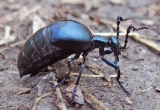
Meloe proscarabaeus
Encyclopedia
Meloe proscarabaeus is a Europe
an oil beetle. It lives in meadow
s, field
margins and other warm sites in all but the far north of the continent. It lacks hind wings
and the elytra
are correspondingly reduced in size.
are laid in the soil by females. Then the larva
e hatch, they climb into a flower
, and await visiting solitary bees. With their well-developed claws, the larvae attach themselves to the bee and return with it to its nest. Here, they feed on the bee's eggs and the pollen
and nectar it had collected. The larva pupates in the bee's nest, and leaves the nest to seek a mate directly afterwards.
Europe
Europe is, by convention, one of the world's seven continents. Comprising the westernmost peninsula of Eurasia, Europe is generally 'divided' from Asia to its east by the watershed divides of the Ural and Caucasus Mountains, the Ural River, the Caspian and Black Seas, and the waterways connecting...
an oil beetle. It lives in meadow
Meadow
A meadow is a field vegetated primarily by grass and other non-woody plants . The term is from Old English mædwe. In agriculture a meadow is grassland which is not grazed by domestic livestock but rather allowed to grow unchecked in order to make hay...
s, field
Field (agriculture)
In agriculture, the word field refers generally to an area of land enclosed or otherwise and used for agricultural purposes such as:* Cultivating crops* Usage as a paddock or, generally, an enclosure of livestock...
margins and other warm sites in all but the far north of the continent. It lacks hind wings
Insect wing
Insects are the only group of invertebrates known to have evolved flight. Insects possess some remarkable flight characteristics and abilities, still far superior to attempts by humans to replicate their capabilities. Even our understanding of the aerodynamics of flexible, flapping wings and how...
and the elytra
Elytron
An elytron is a modified, hardened forewing of certain insect orders, notably beetles and a few of the true bugs ; in most true bugs, the forewings are instead called hemelytra, as only the basal half is thickened while the apex is membranous...
are correspondingly reduced in size.
Life cycle
EggsEgg (biology)
An egg is an organic vessel in which an embryo first begins to develop. In most birds, reptiles, insects, molluscs, fish, and monotremes, an egg is the zygote, resulting from fertilization of the ovum, which is expelled from the body and permitted to develop outside the body until the developing...
are laid in the soil by females. Then the larva
Larva
A larva is a distinct juvenile form many animals undergo before metamorphosis into adults. Animals with indirect development such as insects, amphibians, or cnidarians typically have a larval phase of their life cycle...
e hatch, they climb into a flower
Flower
A flower, sometimes known as a bloom or blossom, is the reproductive structure found in flowering plants . The biological function of a flower is to effect reproduction, usually by providing a mechanism for the union of sperm with eggs...
, and await visiting solitary bees. With their well-developed claws, the larvae attach themselves to the bee and return with it to its nest. Here, they feed on the bee's eggs and the pollen
Pollen
Pollen is a fine to coarse powder containing the microgametophytes of seed plants, which produce the male gametes . Pollen grains have a hard coat that protects the sperm cells during the process of their movement from the stamens to the pistil of flowering plants or from the male cone to the...
and nectar it had collected. The larva pupates in the bee's nest, and leaves the nest to seek a mate directly afterwards.

